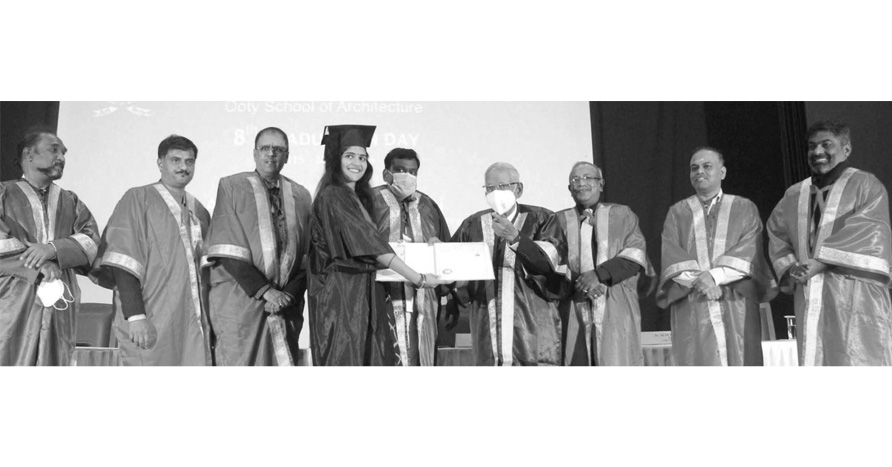8th Convocation Day Address delivered at McGan’s Ooty School of Architecture on 1st November 2021 by Dr. K. Veeramani, Chancellor, Periyar Maniammai Institute of Science & Technology (Deemed to be University), Vallam, Thanjavur.
Dr. K. Veeramani
Respected Director, Principal, Members of Board of Studies, graduates and post graduates, getting conferred with the degrees, and other teaching faculties and staff of McGAN’s Ooty School of Architecture,
Our warm greetings on the occasion of the 8th Annual Convocation of the school of design education. Our dear young, dynamic architect friends, this day is the red letter day in your life. As the adage goes, one’s attitude elevates them to any altitude. Your dream is achieved now but you are entering another phase of your life – a transition from dream world to practical world of life.
You have rightly chosen this field of architecture which was the product of science, due to creative thinking, inventing and transforming the society.
It is because of science and technology particularly the architecture transformed the lives of men and women from hunter – gatherer stage to having settled in houses which were later converted as homes of beauty and utility.
We understand, McGAN’s Ooty School of Architecture has been progressing consistently in offering the design education and its architecture emissaries discharging their scientific and technical responsibilities in various organisations throughout the country. The mission of this school is said to be to nurture and inspire design minded students; who demonstrate a firm foundation of critical thinking and ethical behaviour. It develops as a culture of professional practice on their way to becoming socially responsible leaders of change for our global society.
Critical thinking is the ability to think constructively building up new ideas by the process of association of previously acquired ideas. All our progressive ideas, whether by intution or inspiration, result from such creative thinking. Objectivism should be the hall mark and pre requisite of critical thinking.

The vision of the mission is far and wide not merely benefiting the people confined to a particular geographical area but also the entire humankind. The design education is based on scientific principle that has to be harnessed to the well being and welfare, development and progress of humanity.
The mission of this architecture school reflects the vital provisions of Indian Constitution. Your school’s mission stresses every citizen of our country carrying out the fundamental duty.
A rational approach is backed with critical thinking and adoption of scientific temper, which is adumbrated in our Constitution as the fundamental duty to be performed by all the citizens of our country.
Article 51A(h) of Indian Constitution insists,
It shall be the duty of every citizen of India to develop the scientific temper, humanism and the spirit of inquiry and reform.
But these aspects have not been taught fully in our courses in our academia. Study of Science is different from possessing scientific temper and living up to it.
The spirit of inquiry is not at all encouraging in our institutions. For this, rationalist outlook and approach is the proper road. This is the road less travelled by many of even our taughts and teacher too!.
In essence, rationalist approach must prevail as the guiding star of our daily lives which would enable to come out with success even amidst the trails and tribulations and the task to be accomplished by everyone.
While delivering the Convocation Address at Annamalai University in 1967, the Architect of Dravidian Model Rule, Arignar Anna appealed to the graduates thus: It is more appropriate to quote him:
“Graduates of the Annamalai University, let me call upon you to carry on the crusade against caste which cannot co-exist with democracy, against superstition which cannot co-exist with science and against tyranny of various dimensions which cannot co-exist with liberty, equality and fraternity.
Pursuing vocations for your and your families’ well-being, you have to perform your duty towards society. You are to become torch-bearers of Rationalism. Rationalism does not mean repudiation of basic and fundamental truths and maxims, but the annihilation of dubious modes of thought and action. You have to work hard and with daring and dash, for we have to clear cob-webs which are centuries old and let reason reign supreme.”
In our society we are unable to discriminate between true science and pseudo science.
Even many of our academics are unable to find out the difference between science and pseudoscience, between history and mythologies and so also between religion and philosophy.
Let me cite one example. Architecture is science – a science developing from ancient to the present.
Nowadays superstitions have cropped up alarmingly even in field of architecture and design, limiting the scope of your professional career. Without any formal study, but investing mainly on the superstitious belief of the people, construction and psuedo design ‘experts’ are dominating the scene. The bigotry of people encouraged the deeds of such experts, that is widely practised as vastushastra. Vastu is not science but a blind faith that did not prevail in ancient days and it never stands to the acid test of science.
On one side, science and technology are getting advanced to provide comforts and peace in life but on the other, the faith mongers are extending their career avenues swindling the economic savings of people, whose hard earnings could be deployed in alternative constructive ways. The menace of ‘vastu’ in the design and construction field is a challenge for the duly educated architecture professionals like you.
Dr. Narendra Dabholkar, the martyr in the mission of eradication of superstition and development of scientific temper in Maharashtra has elaborately commented thus on vastushastra in his wonderful book ‘The Case for Reason’ thus:
“Vastushastra, even a few years ago, was restricted only to south India where it was popular. But it has now captured the imagination of the modern, highly, educated people.
Consulting a vastu expert has become
de rigueur before building a bungalow. Existing buildings are altered according to the vastu expert’s advice at the cost of lakhs of rupees. From the location of gates to drinking water tanks, all fixtures are being shifted overnight. And it is not just a fad of the rich. Even the middle class who live in apartments have been duped by vastu shastra. East-facing flats in buildings sell quickly because they are expected to prove auspicious for the owner.
The most objectionable aspect of this vastushastra is its clear espousal of the varnavyavastha (the caste system). According to this shastra, land that is whitish in colour, of sweet character and smells of ghee should be allotted to Brahmins; land whitish in colour but pungent to taste and smelling of blood should be given to Kshatriyas; Vaishyas should get yellowish land, bitter in taste and smelling of food; while the Shudras should be given land that is black in colour, bitter like some decoction and smelling of beverage. Thus this so-called vastushastra is hostile to the values – equality and fraternity, adumbrated in our Constitution. Science just cannot justify or support such a theory.
In addition to the propitiousness or portentousness of the house people get entangled in a host of other things like fate, mantras, talismans, charms, amulets, yagna, fire sacrifices, gurus, maharajas and what not. They lose their free will and, to top it all, justify their decisions as scientific. They strengthen a fatalistic outlook in themselves and in society. If their entire plan fails, they argue – ‘It’s our fate, not vastushastra that has failed us’. This ever-growing defeatist psyche of the urban educated society is very disheartening and forebodes grave danger.”
Vastushastra is not for inclusive growth and development but only for exclusiveness of separation and segreation. Is it not unethical? Is it not antiscience? Is it not unconstitutional?
For instance the Dravidian legacy of architecture is the rich and hoary. From Indus Valley civilization to the present archaeological excavation of Keeladi, the role of architecture is astounding and be an eye opener.
Architecture of Dravidian ancestors
Architecture is not a new domain to Dravidian ancestors. They were well aware of intricacies of design and structuring of buildings and practised them in the formation of their settlements. The archaeological excavations carried out in Tamil Nadu and the artefacts collected prove the level of the knowledge of ancient Tamils in designed construction of structures in their own inimitable style of architecture.
Keeladi
An incredible finding recently is the excavation of Keeladi site in Sivagangai district near Madurai. It reveals the Sangam Age settlement through the exercises carried out by the Archaeological Survey of India and the Tamil Nadu State Department of Archaeology. The settlements had laid on the bank of the River Vaigai, reflecting the ancient design and culture of Tamil people. The excavation findings include the entire settlement pattern, brick walls, roof files, potteries, the sewage canal facilities made of ceramic tubes which belong to 580 BCE.
Grand Anaicut, Kallanai
Not confining to dwelling settlements and designing livable envelopes, our ancestors had always imbibed the aspect of sustainability, wherein the future demands and needs were taken care of. One such stupendous structure continues as the Grand Anaicut of Kallanai near Trichy. It is one of the country’s oldest surviving dams and is a pride of architecture of this land. It is an architectural marvel passed down to several generations and still serves the populace around the area, popularly known as the Rice Bowl of Tamil Nadu. This dam makes the design truly an inspiration for the largest dams, conserving water and its due dispensation and distribution to the ayacut (benefitting) areas. Before the modifications made by the British, the original Kallanai dam had some unique design features which worked well for both the environment and residents. The features include the curved shape of the masonry section, an irregular descent and a sloping crest. All these design features reshaped the water current flowing towards the dam smoothly and it had a good sedimentation process.
Now in our twenty first century, the horizon of our knowledge knows no bounds’.
Future design technologies: Design in other planets (like Mars)
This is New Age when Merging of Mind and Machine is the pride of lives.
The architecture students of Periyar Maniammai Institute of Science and Technology (Deemed to be University) Vallam, Thanjavur have explored the possibilities of future design technology through hypothetical thesis (housing design in the planet Mars). NASA of United States of America was contacted, details were collected and guidance obtained.
The developed Martian concrete is highly feasible for construction in Mars. The Martian concrete is mechanically stimulated by a discrete particle model. Further research is in progress worldwide towards designed constructions in the planet, Mars.
How is the knowledge of Science in 21st century?
Prof. Michio Kaku, author of hyperspace in his book, ‘VISIONS – How Science Will Revolutionize the 21st Century and Beyond’ has pointed about the smart office and home of the future thus:
“Historically, one of the first devices of our office or home to become “smart” was the typewriter. In the future, if a big storm is predicted, your home will pick up a weather forecast from the Internet and make the proper preparations, raising the temperature, alerting family members and providing the latest updates. The smart bath room will monitor family members’ health.

In Japan, a computerized toilet is being marketed which can diagnose simple medical problems. A person’s pulse can be taken by the toilet seat by sensing the tiny pulse in the thighs. Urine can be chemically analyzed for diabetics.
Although these medical diagnostic tools are still primitive, in the future scientists expect them to blossom into sophisticated medical analyzers, acting as an electrocardiogram for the heart and detecting proteins emitted by precancerous tissues. In the distant future, the smart home may serve as a computerized nurse, carefully analyzing a person’s state of health and sending the information silently and automatically to his or her doctor.”
This is what we call ‘Artificial Intelligence (AI)’, you are going to build smart houses develop spirit of inquiry and humanism, equality and ensuring social justice.
The great icon of Rationalism, Thanthai Periyar through abundant commonsense and original, creative thinking envisioned in his lecture, ‘World to Come – where he visualized and could see vast sea of changes incubating in future. He was a great humanist with critical thinking that too creative. What he liked to see was his analysis and thoughts emerging into reality.
In that way Thanthai Periyar served the society as a social scientist, more specifically as a social architect wherein the advantages of the development of science and technology could be explored fully. At present the scientific advancements are being utilized by youngsters. Most of the present youngsters have not seen Periyar in person but they are benefited by his envisioning the future. That is why Periyar is popular among the present generation.
We appeal to the young architecture professionals to proceed in your career with the awareness of the field as a science. Contribute your might constructively with the fervour of scientific temper. Be cautious and avoid getting trapped in pseudo science. Protect the needy people who would approach in your career. Put an end to the construction or celebration in the name of ‘vastu’, causing heavy economic loss and mental agony to your clients. We greet you, architecture graduates on this memorable occasion in your life and wish you all success!





